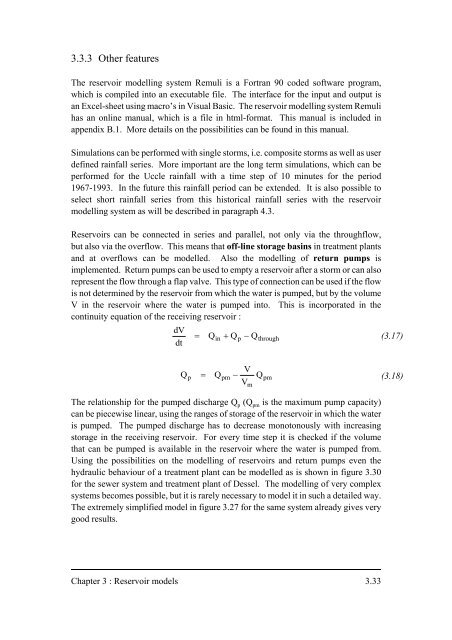Chapter 3 : Reservoir models - KU Leuven
Chapter 3 : Reservoir models - KU Leuven
Chapter 3 : Reservoir models - KU Leuven
Create successful ePaper yourself
Turn your PDF publications into a flip-book with our unique Google optimized e-Paper software.
3.3.3 Other features<br />
The reservoir modelling system Remuli is a Fortran 90 coded software program,<br />
which is compiled into an executable file. The interface for the input and output is<br />
an Excel-sheet using macro’s in Visual Basic. The reservoir modelling system Remuli<br />
has an online manual, which is a file in html-format. This manual is included in<br />
appendix B.1. More details on the possibilities can be found in this manual.<br />
Simulations can be performed with single storms, i.e. composite storms as well as user<br />
defined rainfall series. More important are the long term simulations, which can be<br />
performed for the Uccle rainfall with a time step of 10 minutes for the period<br />
1967-1993. In the future this rainfall period can be extended. It is also possible to<br />
select short rainfall series from this historical rainfall series with the reservoir<br />
modelling system as will be described in paragraph 4.3.<br />
<strong>Reservoir</strong>s can be connected in series and parallel, not only via the throughflow,<br />
but also via the overflow. This means that off-line storage basins in treatment plants<br />
and at overflows can be modelled. Also the modelling of return pumps is<br />
implemented. Return pumps can be used to empty a reservoir after a storm or can also<br />
represent the flow through a flap valve. This type of connection can be used if the flow<br />
is not determined by the reservoir from which the water is pumped, but by the volume<br />
V in the reservoir where the water is pumped into. This is incorporated in the<br />
continuity equation of the receiving reservoir :<br />
dV<br />
dt<br />
= Qin + Qp − Qthrough<br />
(3.17)<br />
Q<br />
p<br />
V<br />
= Qpm<br />
−<br />
V<br />
Q pm<br />
(3.18)<br />
m<br />
The relationship for the pumped discharge Q p (Q pm is the maximum pump capacity)<br />
can be piecewise linear, using the ranges of storage of the reservoir in which the water<br />
is pumped. The pumped discharge has to decrease monotonously with increasing<br />
storage in the receiving reservoir. For every time step it is checked if the volume<br />
that can be pumped is available in the reservoir where the water is pumped from.<br />
Using the possibilities on the modelling of reservoirs and return pumps even the<br />
hydraulic behaviour of a treatment plant can be modelled as is shown in figure 3.30<br />
for the sewer system and treatment plant of Dessel. The modelling of very complex<br />
systems becomes possible, but it is rarely necessary to model it in such a detailed way.<br />
The extremely simplified model in figure 3.27 for the same system already gives very<br />
good results.<br />
<strong>Chapter</strong> 3 : <strong>Reservoir</strong> <strong>models</strong> 3.33
















